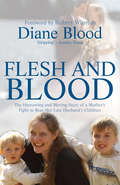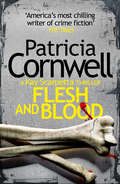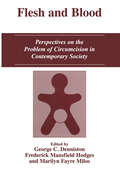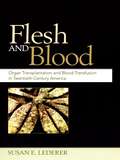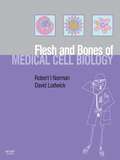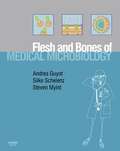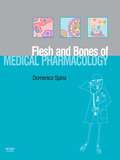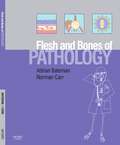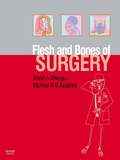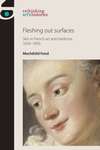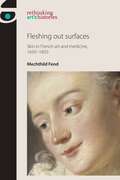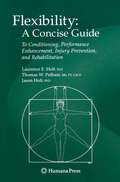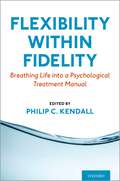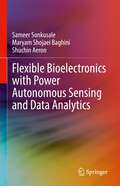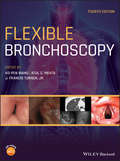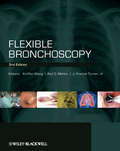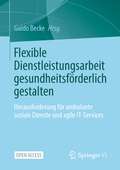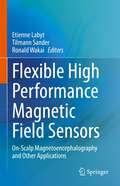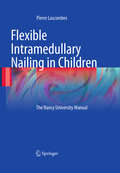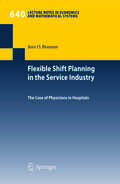- Table View
- List View
Flesh and Blood: The Harrowing and Moving Story of a Mother's Fight to Bear Her Late Husband's Children
by Diane Blood AuthorDiane Blood first hit the headlines in 1996 when she went to court to fight for the right to use her late husband's sperm to try for the child they had planned together before his sudden death from meningitis. Diane's case caused an ethical storm and was debated in the courts, in Parliament and in the media. With huge public support, yet against almost impossible odds, she won on appeal and went on to have two miraculous little boys. The legal battles were not over, however, as the law still prevented Diane from naming the boys' father on their birth certificates. After many hurdles and stumbling blocks, she triumphed again and made constitutional history when the Human Fertilisation and Embryology (Deceased Fathers) Act finally came into force on 1 December 2003 and she was allowed to re-register her children's births. Flesh and Blood asks many important questions and helps provide some of the answers. It shows how controversial policies are made that affect all our lives. Beyond that, it is a simple story of life, death and procreation: an incredibly vivid account written by the woman who lived through the despair and jubilation.
Flesh and Blood (Kay Scarpetta Novels Ser. #22)
by Patricia CornwellNo.1 bestselling author Patricia Cornwell delivers the next enthralling thriller in her high-stakes series starring Kay Scarpetta—a complex tale involving a serial sniper who strikes chillingly close to the forensic sleuth herself.
Flesh and Blood: Perspectives on the Problem of Circumcision in Contemporary Society
by Marilyn FayreMilos Frederick MansfieldHodges George C. DennistonWho owns your sex organs? Different cultures today and in different epochs have given a variety of answers to this question. It may seem self evident that every individual owns and has sovereignty over his or her own body parts, such as the head, legs, nose, stomach, pancreas, and other body parts. The sex organs, however, seem to be an exception. Even though they are as much an integral part of the individual as a leg or a liver, the sex organs are unique in that many cultures have established laws and taboos over the use and even the mere display of the sex organs. Thus, certain cultures have placed constraints over the individual's ownership of his or her sex organs and actively regulate and restrict the individual's access and use of those organs. In other cultures, the question of ownership of the sex organs is more decisively answered. In any culture where circumcision to any degree of either the male or female is practiced, permitted, encouraged, or even merely tolerated, it is clear that the individual is not considered to own his own sex organs. In the United States today, the medical establishment has created an is considered acceptable and desirable that anyone for environment where it any reason can authorize or execute the amputation of the foreskin from a male child's penis.
Flesh and Blood: Organ Transplantation and Blood Transfusion in 20th Century America
by Susan E. LedererOrgan transplantation is one of the most dramatic interventions in modern medicine. Since the 1950s thousands of people have lived with 'new' hearts, kidneys, lungs, corneas, and other organs and tissues transplanted into their bodies. From the beginning, though, there was simply a problem: surgeons often encountered shortages of people willing and able to give their organs and tissues. To overcome this problem, they often brokered financial arrangements. Yet an ethic of gift exchange coexisted with the 'commodification of the body'. The same duality characterized the field of blood transfusion, which was essential to the development of modern surgery. This book will be the first to bring together the histories of blood transfusion and organ transplantation. It will show how these two fields redrew the lines between self and non-self, the living and the dead, and humans and animals. Drawing on newspapers, magazines, legal cases, films and the papers and correspondence of physicians and surgeons, Lederer will challenge the assumptions of some bioethicists and policymakers that popular fears about organ transplantation necessarily reflect timeless human concerns and preoccupations with the body. She will show how notions of the body- intact, in parts, living and dead- are shaped by the particular culture in which they are embedded.
The Flesh and Bones of Medical Cell Biology E-Book (Flesh & Bones)
by Robert I. Norman David LodwickThis title is directed primarily towards health care professionals outside of the United States. THE FLESH AND BONES OF MEDICAL CELL BIOLOGY presents a concise, accessible account of medical cell biology. This title covers all the key concepts med students need with no gaps. It can be used either as an introduction to a topic, or as a revision aid. In Section 1, The Big Picture overview gives a descriptive overview of a subject. In the High Yield section, 50 fundamental principles underlying a subject are set out. These 50 principles are expanded into double-page spreads in the 'Fleshed Out' section where double-page explanations of the key principles clearly convey what medical students need to know. Difficult concepts are depicted by cartoon-strip illustrations, which enable rapid understanding and assimilation of information.Big Picture Section - enables readers to relate detail to the subject as a wholeHigh Return Facts - prevents students from having large gaps in their knowledge. Can be used as a revision tool. Reinforces the major points.Cartoon-strip illustrations - enable students to visualize difficult concepts in a step-by-step format. Allow information to be chunked into student-friendly sizes.Double-page overviews - students can read summary of topic without cross-referencing to other pages. All laid out on one spread.
The Flesh and Bones of Medical Microbiology E-Book (Flesh & Bones)
by Andrea Guyot Silke Schelenz Steven H. MyintThe Flesh and Bones of Medical Microbiology presents a very clinically orientated account of the subject. It covers all the key concepts you need with no gaps. It can be used either as an introduction to a topic, or as a revision aid. Dfficult concepts are depicted by cartoon-strip illustrations, helping you to quickly understand information.Big Picture Section - lets you relate detail to the subject as a wholeHigh Return Facts - prevents you from having large gaps in your knowledge. Can be used as a revision tool. Reinforces the major pointsCartoon-strip illustrations - enables you to visualise difficult concepts in a step-by-step format - information can be chunked into 'student-friendly' sizesDouble-page overviews - you can read topic summaries without cross-referencing to other pages. All laid out on one spread
The Flesh and Bones of Medical Pharmacology E-Book (Flesh & Bones)
by Domenico SpinaA concise, accessible account of pharmacology and covers all the key concepts med students need with no gaps! Perfect as an introduction to a topic, or as a revision aid.Big Picture Section - you can relate detail to the subject as a wholeHigh Return Facts - fills large gaps in your knowledge. Can be used as a revision tool. Reinforces the major pointsCartoon-strip illustrations - you can visualise difficult concepts in a step-by-step format - information is chunked into 'student-friendly' sizesDouble-page overviews - read topic summaries without cross-referencing to other pages - they're all laid out in one spread!
The Flesh and Bones of Pathology E-Book (Flesh & Bones)
by Adrian C. Bateman Norman CarrTHE FLESH AND BONES OF MEDICAL PATHOLOGY presents a clinically-orientated account of the subject, covering all the key concepts you need with no gaps. You can use it either as an introduction to pathology, or as a revision aid.Big Picture Section - helps you to relate detail to the subject as a wholeHigh Return Facts - reinforces the major points and lets you fill any large gaps in your knowledgeCartoon-strip illustrations - lets you visualise difficult concepts in a step-by-step format, and allows information to be grouped into student-friendly sizesDouble-page overviews - all laid out in one spread, so you can read topic summaries without cross-referencing to other pages
The Flesh and Bones of Surgery E-Book (Flesh & Bones)
by Aneel Bhangu Michael R. KeighleyThis title is directed primarily towards health care professionals outside of the United States. It presents a concise and accessible account of this key subject in the undergraduate medical curriculum. It covers all the key concepts medical students need with no gaps. It can be used either as an introduction to a topic, or as a revision aid. In Section 1, The Big Picture overview gives a descriptive overview of a subject in 8pp. In the High Return section, 50 fundamental principles underlying a subject are set out. These 50 principles are expanded into double-page spreads in the 'Fleshed Out' section where double-page explanations of the key principles clearly convey what medical students need to know. Difficult concepts are depicted by cartoon-strip style illustrations, which enable rapid understanding and assimilation of information.Big Picture Section - enables readers to relate detail to the subject as a wholeHigh Return Facts - prevents students from having large gaps in their knowledge. Can be used as a revision tool. Reinforces the major pointsCartoon-strip illustrations - enable students to visualize difficult concepts in a step-by-step format. Allow information to be chunked into student-friendly sizes.Double-page overviews - students can read summary of topic without cross-referencing to other pages. All laid out on one spread.
Fleshing out surfaces: Skin in French art and medicine, 1650–1850 (PDF) (Rethinking Art's Histories)
by Mechthild FendA strong and insightful work which argues that skin is not just any surface an artist can represent, but a highly overdetermined one. Focusing on five French painters - Fragonard, David, Girodet, Benoit and Ingres - it spans the fields of history of art and of medicine.
Fleshing out surfaces: Skin in French art and medicine, 1650–1850 (Rethinking Art's Histories)
by Mechthild FendA strong and insightful work which argues that skin is not just any surface an artist can represent, but a highly overdetermined one. Focusing on five French painters - Fragonard, David, Girodet, Benoit and Ingres - it spans the fields of history of art and of medicine.
Flexibility: To Conditioning, Performance Enhancement, Injury Prevention, and Rehabilitation (Musculoskeletal Medicine)
by Laurence E. Holt Thomas E. Pelham Jason HoltHere is a definitive guide to flexibility that revises the conceptual framework of the field. From the conceptual foundations of research to the practical applications of stretching techniques in a number of domains, this book provides a fresh perspective on flexibility, one that challenges current thinking and professional practice. It covers all major types of flexibility technique and training, with an emphasis on when and how to use each method safely and effectively. Specific applications to rehabilitation, sport, fitness, and dance make this book an invaluable resource for all practitioners and professionals in the field of human movement.
Flexibility within Fidelity: Breathing Life into a Psychological Treatment Manual
by Philip C. KendallAmong mental health researchers, there is a consensus that empirically supported treatments (ESTs) have favorable outcomes and that the outcomes are typically better than other approaches. The majority of these are available as therapist manuals, brief books, or other extended volumes. However, among mental health service providers, there is often a view that these manuals and books can be formulaic and rigid, and likely insensitive to individual patient needs or presentations. With these conflicting perspectives in place, there is a need for accurate communication and reconciliation. Flexibility within Fidelity identifies how effective ESTs can be implemented with both integrity and flexibility. The book is comprised of chapters focusing on specific ESTs for identified problem areas amongst adults and children/adolescents, including anxiety disorders, PTSD, pain management, and depression among others. Chapter authors focus on the specific treatment components that are required to maintain fidelity and the features of the EST which can be applied with flexibility, promoting a personalized implementation. Written in an accessible style featuring in-depth clinical discussions, this book will equip mental health practitioners with the tools to implement ESTs across client presentations.
Flexibility within Fidelity: Breathing Life into a Psychological Treatment Manual
by Philip C. KendallAmong mental health researchers, there is a consensus that empirically supported treatments (ESTs) have favorable outcomes and that the outcomes are typically better than other approaches. The majority of these are available as therapist manuals, brief books, or other extended volumes. However, among mental health service providers, there is often a view that these manuals and books can be formulaic and rigid, and likely insensitive to individual patient needs or presentations. With these conflicting perspectives in place, there is a need for accurate communication and reconciliation. Flexibility within Fidelity identifies how effective ESTs can be implemented with both integrity and flexibility. The book is comprised of chapters focusing on specific ESTs for identified problem areas amongst adults and children/adolescents, including anxiety disorders, PTSD, pain management, and depression among others. Chapter authors focus on the specific treatment components that are required to maintain fidelity and the features of the EST which can be applied with flexibility, promoting a personalized implementation. Written in an accessible style featuring in-depth clinical discussions, this book will equip mental health practitioners with the tools to implement ESTs across client presentations.
Flexible Batteries
by Ye Zhang Lie Wang Yang Zhao Huisheng PengFlexible Batteries highlights the key advances in flexible batteries, a booming new direction in the energy storage field. The authors first introduce lithium-ion batteries, which are currently the most widely used batteries. Flexible aqueous batteries such as aqueous lithium-ion, sodium-ion, and zinc-ion batteries are discussed subsequently due to the safety concerns in organic electrolytes. Since flexible metal-air batteries are recognized as primary choices for the next generation, the authors take lithium-air and aluminum-air batteries as examples to explore their applications in flexible battery construction. They further summarize flexible batteries under the most challenging working conditions such as stretching and integrating flexible batteries with flexible energy harvesting devices, sensors, and supercapacitors. Covering both fundamental and application development, this book may effectively bridge academics and industry. It will be helpful not only to scholars and students studying materials science and engineering, chemical engineering, physics, energy science, and biomedical science but also to scientists and engineers in the industry.
Flexible Batteries
by Ye Zhang Lie Wang Yang Zhao Huisheng PengFlexible Batteries highlights the key advances in flexible batteries, a booming new direction in the energy storage field. The authors first introduce lithium-ion batteries, which are currently the most widely used batteries. Flexible aqueous batteries such as aqueous lithium-ion, sodium-ion, and zinc-ion batteries are discussed subsequently due to the safety concerns in organic electrolytes. Since flexible metal-air batteries are recognized as primary choices for the next generation, the authors take lithium-air and aluminum-air batteries as examples to explore their applications in flexible battery construction. They further summarize flexible batteries under the most challenging working conditions such as stretching and integrating flexible batteries with flexible energy harvesting devices, sensors, and supercapacitors. Covering both fundamental and application development, this book may effectively bridge academics and industry. It will be helpful not only to scholars and students studying materials science and engineering, chemical engineering, physics, energy science, and biomedical science but also to scientists and engineers in the industry.
Flexible Bioelectronics with Power Autonomous Sensing and Data Analytics
by Sameer Sonkusale Maryam Shojaei Baghini Shuchin AeronThis book provides readers with an introduction to the materials and devices necessary for flexible sensors and electronics, followed by common techniques for fabrication of such devices and system-level integration. Key insights into fabrication and processing will guide readers through the tradeoff choices in designing such platforms. A comprehensive review of two specific, flexible bioelectronic platforms, related to smart bandages for wound monitoring and thread-based diagnostics for wearable health, will demonstrate practical application at the system level. The book also provides a unique electrical engineering perspective by reviewing circuit architectures for low noise signal conditioning of weak signals from sensors,, and for low power analog to digital converters for signal acquisition. To achieve energy autonomy, authors provide several example of CMOS energy harvesting front end circuits and voltage boosters. Beyond circuit architectures, the book also provides a review of the modern theory of sampling and recovery of sparse signals, also known as compressed sensing. They then highlight how these principles can be leveraged for design and implementation of efficient signal acquisition hardware and reliable processing of acquired data for flexible electronic platforms.
Flexible Bronchoscopy
by Ko Pen Wang Atul C. Mehta J. Francis TurnerIn this fourth edition of the popular Flexible Bronchoscopy, which has been revised and updated throughout, the world's leading specialists discuss the technical and procedural aspects of performing diagnostic and therapeutic bronchoscopy. Four new chapters have been added, taking into account new developments in EBUS and electromagnetic navigation.
Flexible Bronchoscopy
by Ko-Pen Wang Atul C. Mehta J. Francis TurnerWith the development of new instruments and the refining of new techniques, flexible bronchoscopy has become one of the most frequently performed invasive procedures in pulmonary medicine. This new edition of Flexible Bronchoscopy is an essential addition to the bronchoscopist's bookshelf. It highlights possible complications, contra-indications and precautions. In addition it addresses all current techniques and future technologies in interventional bronchoscopy. For ease of use Flexible Bronchoscopy is divided into four major sections: Fundamentals of Bronchoscopy Diagnostic Bronchoscopy Therapeutic Bronchoscopy Special Considerations Flexible Bronchoscopyis an ideal training manual for all respiratory and pulmonary physicians, as well as trainees and residents working in the field of respiratory medicine, who need to develop the skill of interventional bronchoscopy.
Flexible Bronchoscopy
by Ko-Pen Wang Atul C. Mehta J. Francis TurnerIn this fourth edition of the popular Flexible Bronchoscopy, which has been revised and updated throughout, the world's leading specialists discuss the technical and procedural aspects of performing diagnostic and therapeutic bronchoscopy. Four new chapters have been added, taking into account new developments in EBUS and electromagnetic navigation.
Flexible Bronchoscopy
by Ko-Pen Wang Atul C. Mehta J. Francis Turner Jr.With the development of new instruments and the refining of new techniques, flexible bronchoscopy has become one of the most frequently performed invasive procedures in pulmonary medicine. This new edition of Flexible Bronchoscopy is an essential addition to the bronchoscopist's bookshelf. It highlights possible complications, contra-indications and precautions. In addition it addresses all current techniques and future technologies in interventional bronchoscopy. For ease of use Flexible Bronchoscopy is divided into four major sections: Fundamentals of Bronchoscopy Diagnostic Bronchoscopy Therapeutic Bronchoscopy Special Considerations Flexible Bronchoscopyis an ideal training manual for all respiratory and pulmonary physicians, as well as trainees and residents working in the field of respiratory medicine, who need to develop the skill of interventional bronchoscopy.
Flexible Dienstleistungsarbeit gesundheitsförderlich gestalten: Herausforderung für ambulante soziale Dienste und agile IT-Services
by Guido BeckeDies ist ein Open-Access-Buch.Im Zentrum des Bands steht die gesundheitsförderliche Gestaltung flexibler Dienstleistungsarbeit. Am Beispiel von technischen, d. h. agilen IT-Services und sozialen, d. h. ambulanten hauswirtschaftlichen Diensten werden Belastungskonstellationen und Gesundheitsressourcen von Beschäftigten im Umgang mit Flexibilitätsanforderungen analysiert. Zugleich werden betrieblich erprobte und evaluierte Interventionslösungen sowie Erfahrungen ihres regionalen Transfers diskutiert. Es zeigt sich, dass beide Beispielbereiche flexibler Dienstleistungsarbeit durch relativ hohe Anforderungen an die Interaktionsarbeit mit Kund*innen geprägt, aber in unterschiedliche Interaktionsordnungen eingebunden sind. Vorstellungen von einfacher hauswirtschaftlicher Dienstleistungsarbeit sind in Anbetracht komplexer Interaktionsanforderungen zu revidieren.
Flexible High Performance Magnetic Field Sensors: On-Scalp Magnetoencephalography and Other Applications
by Etienne Labyt Tilmann Sander Ronald WakaiThis contributed volume reviews the latest advances in all the new technologies currently developed for MagnetoEncephaloGraphy (MEG) recordings, as well as sensor technologies and integrated sensor arrays for on-scalp MEG. The book gives an account of the first MEG imaging studies and explores the new field of feasible, experimental paradigms of on-scalp MEG. This is an ideal book for engineers, researchers, and students in the neurosciences interested in MEG imaging.
Flexible Intramedullary Nailing in Children: The Nancy University Manual
by Pierre LascombesOver the past three decades, the flexible intramedullary nailing (FIN) technique that originated in the University of Nancy in France has evolved to the point where it is becoming the gold standard for the treatment of many fractures in children. This comprehensive textbook on FIN is written by Pierre Lascombes and his colleagues from the University of Nancy and covers all its potential applications. The book is divided into three parts. The first part focuses on general considerations such as biomechanics, choice of implant, basic principles of surgical technique, and rehabilitation. The second part describes in detail the techniques developed for each particular fracture type with the aid of numerous high-quality illustrations. In the final part, a range of further indications for FIN in children are discussed. By clearly explaining the basic principles and various uses of FIN, this book will prove of value to both novice and experienced traumatologists and orthopedic surgeons.
Flexible Shift Planning in the Service Industry: The Case of Physicians in Hospitals (Lecture Notes in Economics and Mathematical Systems #640)
by Jens O. BrunnerThe introductory chapter consists of four sections. In Sect. 1. 1 we reveal the c- rent situation in hospitals that is faced by the management. We address the general issue of personnel scheduling in the service industry in Sect. 1. 2. Then we motivate our research by considering physicians as the scheduling object. In particular, we show the complex nature of physician scheduling in a hospital environment. The focus of the research is presented in Sect. 1. 3. Finally, we conclude the chapter by illustrating the outline of the thesis. 1. 1 General Economic Situation in Hospitals The mounting pressure in the health care industry to reduce costs is forcing hos- tals and related facilities to take a closer look at their staf?ng policies (see [111]). A primary dif?culty in reducing personnel costs, the major component of the budget, is the variability in demand and the need to assign staff to ?xed shifts. Furthermore, government run facilities, especially those in the European Union, are seeing their budgets cut in terms of real dollars despite an aging and more acutely ill patient population (e. g. , see [96]). It has been reported that up to a third of the hospitals in Germanyplan a reductionin staff (see [91]). The schedulingprocess is furtherc- plicated by the generally recognized importance of taking individual preferences intoaccount. Moreattractiveschedulespromotejobsatisfaction,increaseproduct- ity,and reduceturnover(cf. [2]). However,withoutimprovedschedulingprocedures that better match supplyto demand,the level of care that theynow providewill soon become unsustainable. 1.
